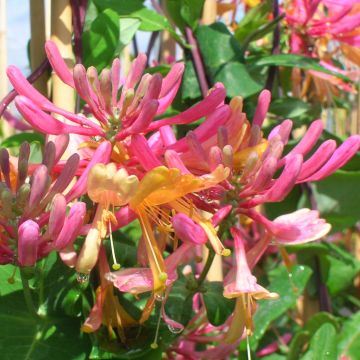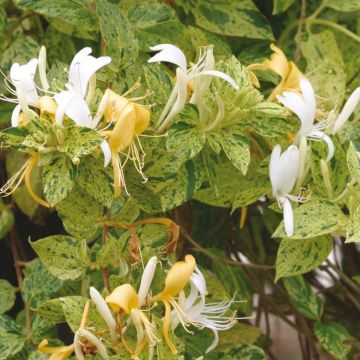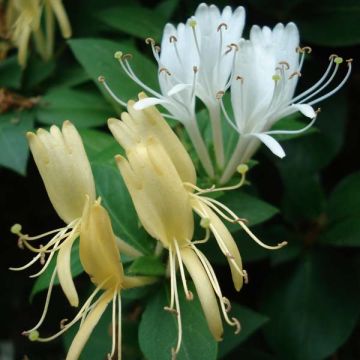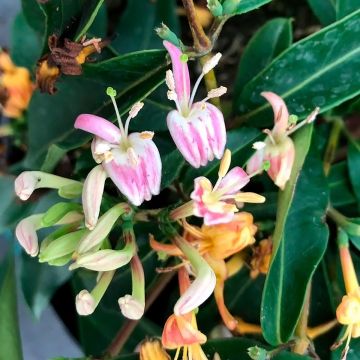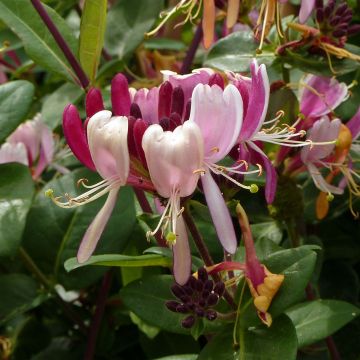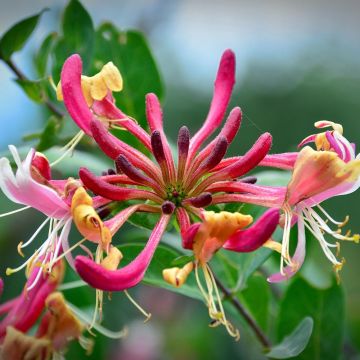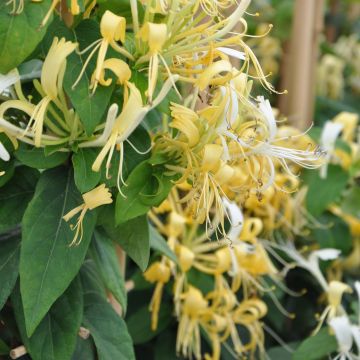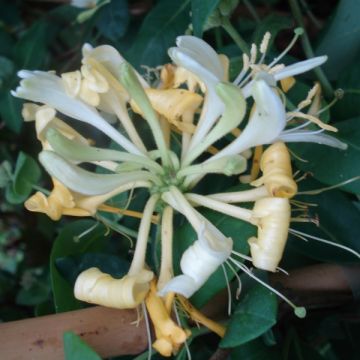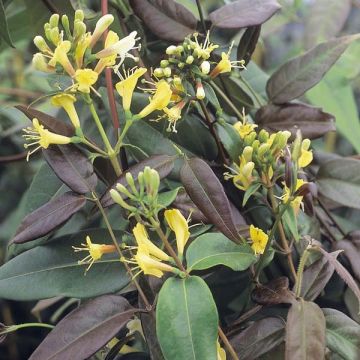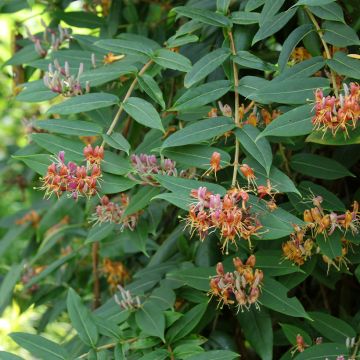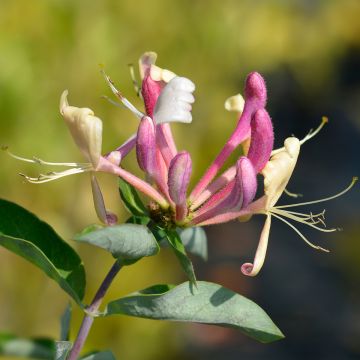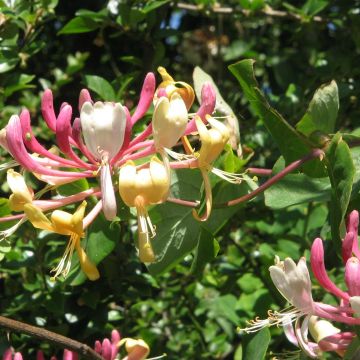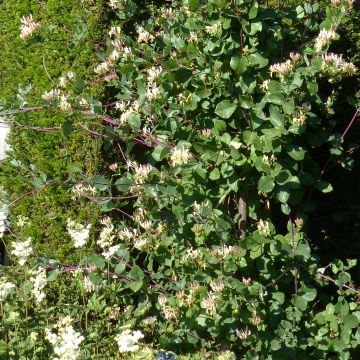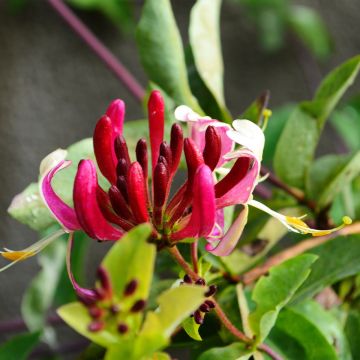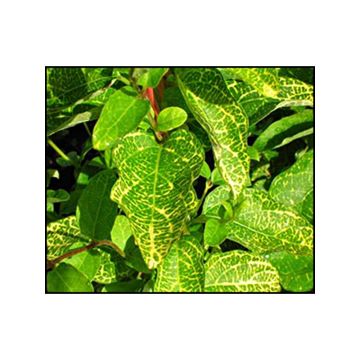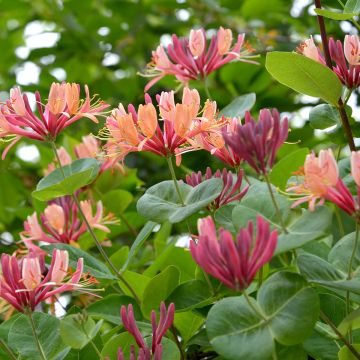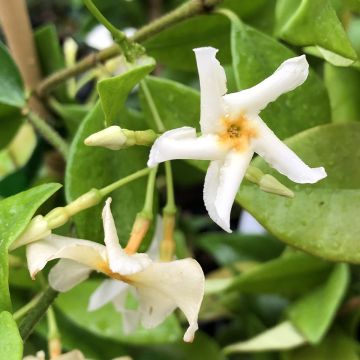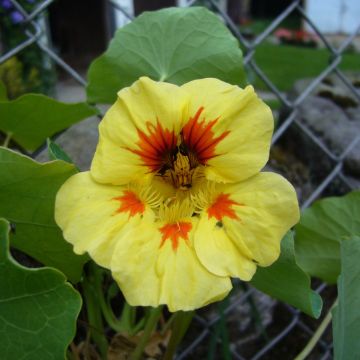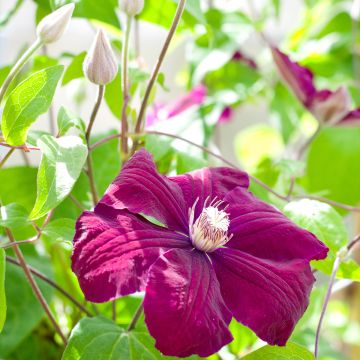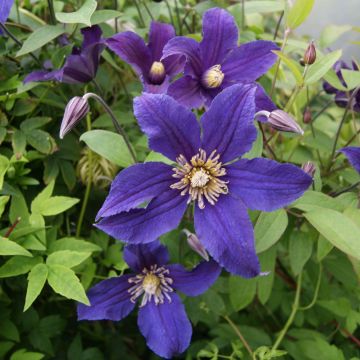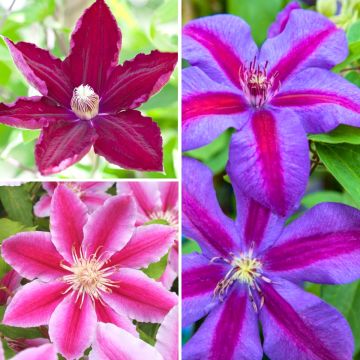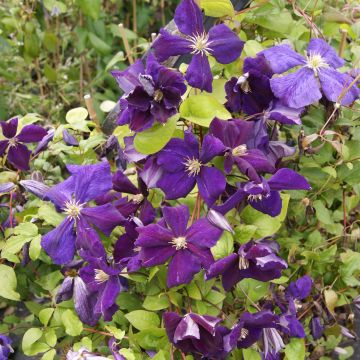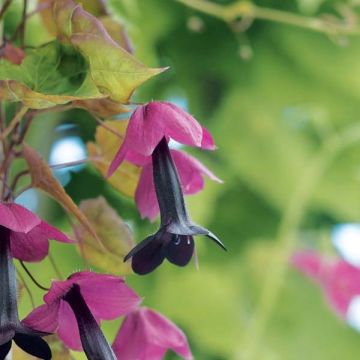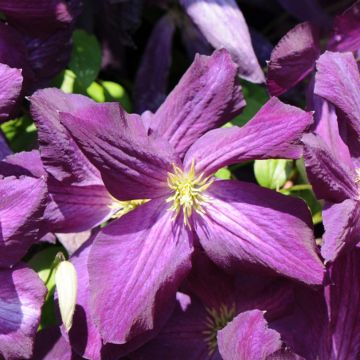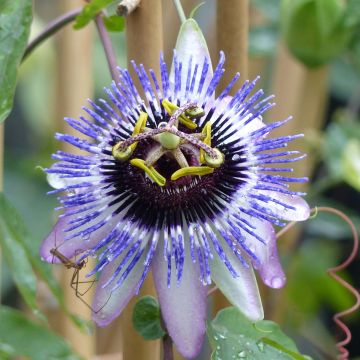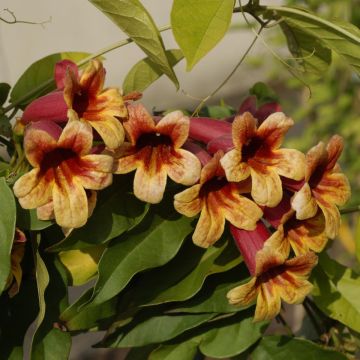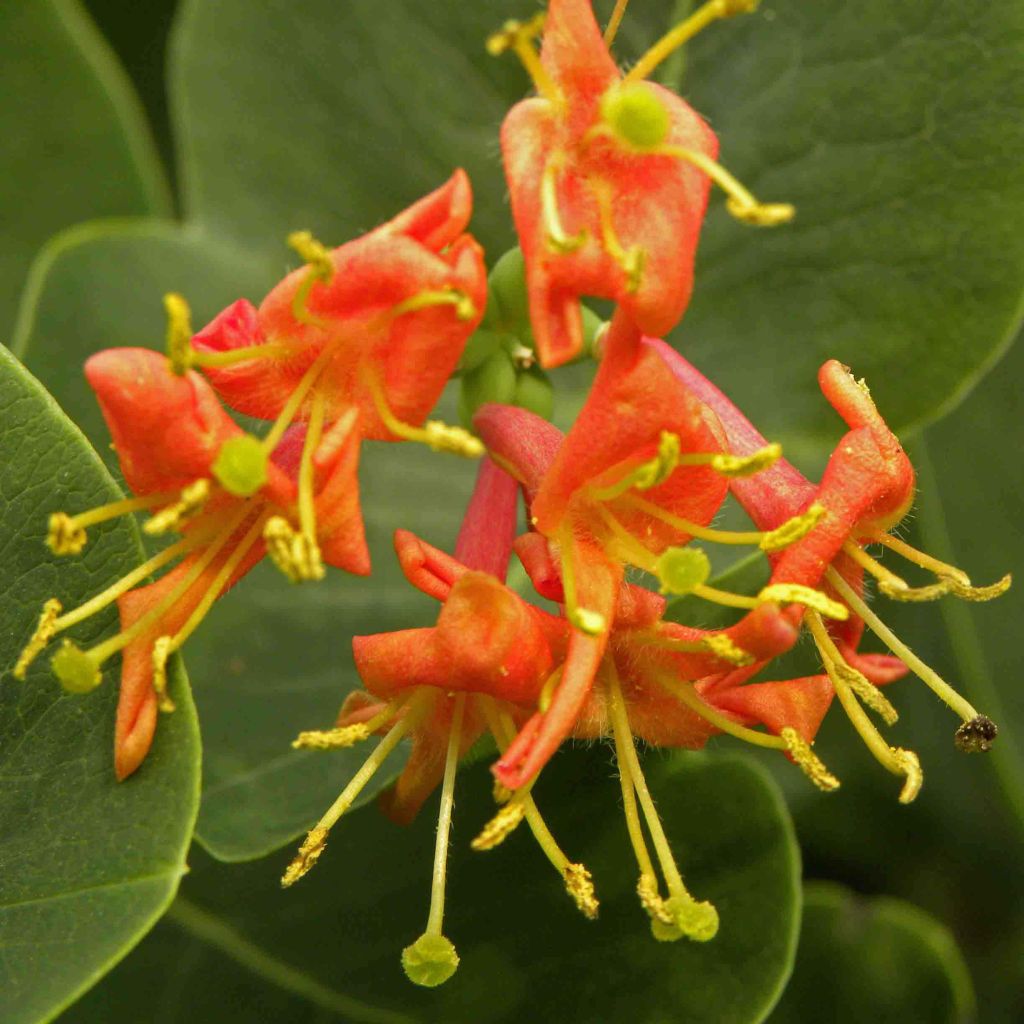

Lonicera x heckrottii Firecracker
Lonicera x heckrottii Firecracker
Lonicera x heckrottii Firecracker®
Honeysuckle
Well-packaged but damaged plant Average recovery
Melanie B., 10/02/2021
Why not try an alternative variety in stock?
View all →This plant carries a 6 months recovery warranty
More information
We guarantee the quality of our plants for a full growing cycle, and will replace at our expense any plant that fails to recover under normal climatic and planting conditions.
From €5.90 for pickup delivery and €6.90 for home delivery
Express home delivery from €8.90.
Delivery to Corse prohibited: UE law prohibits the import of this plant from mainland France to Corse as part of the fight against Xylella fastidiosa. Please accept our sincere apologies.
More information
Does this plant fit my garden?
Set up your Plantfit profile →
Description
Lonicera x heckrotii 'Firecracker' is a honeysuckle with a climbing, compact and bushy habit, and moderate dimensions, which allows it to be integrated into a small garden or grown in a large pot on the patio. It seduces with its long and abundant summer flowering, vividly coloured with floral and spicy scents. Its flowers, very numerous, in a mix of pink, salmon and orange tones, are enhanced by a beautiful green-blue foliage, more or less evergreen in winter depending on the climate. This variety is also very ornamental when grown as a shrub, in a hedge or a field of plants.
The Lonicera x Heckrotii 'Firecracker' is a horticultural hybrid with uncertain origins. Its parent, L. x Heckrotii, is the result of the cross-breeding of L.sempervirens and L. americana. These plants all belong to the Caprifoliaceae family. 'Firecracker' is a deciduous to evergreen variety, with a shrub-like to climbing habit. The mature plant will reach an average height of 3m (10ft) with a spread of 2m (7ft). The particularly generous flowering from June-July to September occurs at the end of the young shoots, throughout the growth period. The tubular flowers, 4cm (2in) long, are a deep pink-red-violet colour and open on two lips that change from salmon pink to orange, and emit a powerful fragrance. They are arranged in dense whorls in the axils of the leaves, producing some non-edible red berries. The young voluble branches are reddish in colour, as well as the juvenile foliage, adding an ornamental touch of colour to this charming honeysuckle. The foliage consists of sheathing and rounded leaves, 5cm (2in) long, with a beautiful green-blue hue and a pruinose appearance when ripe.
Lonicera Firecracker can be trained to climb on a trellis, a fence or an espalier, especially on a pergola located on a patio, a terrace, or near the house where its fragrant flowering will be highly appreciated. It can also, according to each person's desires and tastes, be placed on a fence or a stone wall where it will gracefully cascade. When grown as a shrub, it will enhance a flower bed close to the house or the foreground of a flowering hedge, the edge of a grove... There are plenty of combinations with clematis: for example, it can be associated with small clematis such as Clematis patens Shin-Shigyoku, Prince Charles, winter jasmine or officinalis, perennial peas (Lathyrus latifolius), a small climbing rose 'Laguna', bright pink or Ghislaine de Féligonde and Alchemist in warm tones.
Report an error about the product description
Lonicera x heckrottii Firecracker in pictures
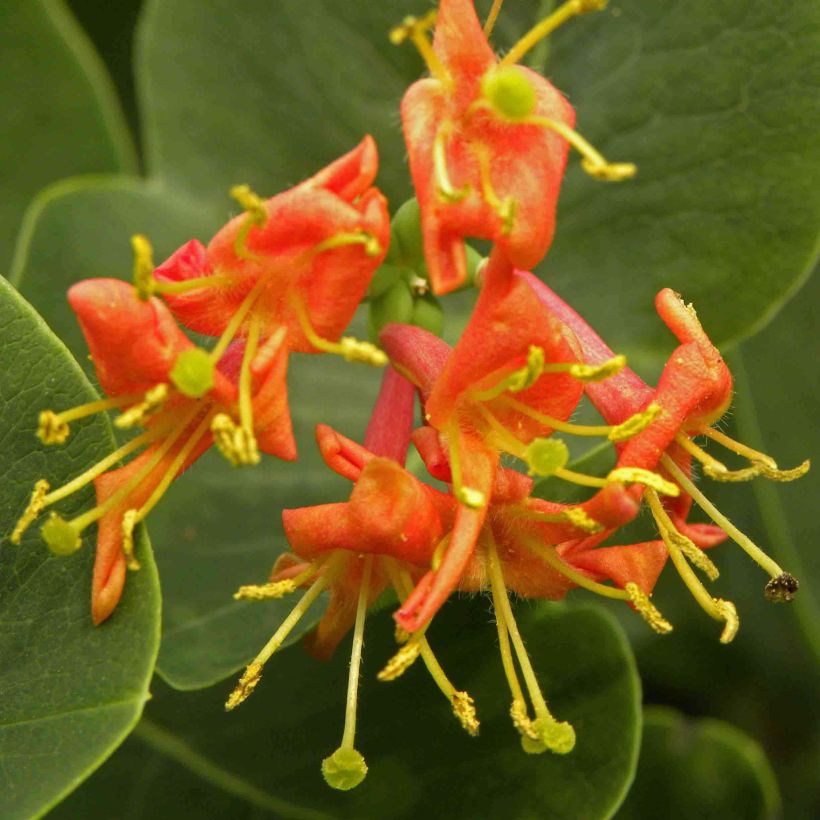

Plant habit
Flowering
Foliage
Botanical data
Lonicera
x heckrottii
Firecracker®
Caprifoliaceae
Honeysuckle
Cultivar or hybrid
Other Honeysuckle
Planting and care
Honeysuckles thrive in any good deep garden soil, which is not too chalky, in a gently sunny exposure. Practice an annual cleaning pruning. However, it is possible to severely cut back an old subject to completely renew the framework. This restoration will take place over one or two years. Honeysuckles are hardy climbing plants, ideal for quickly dressing a wall or a pergola. Provide them with support, they will cling on their own by winding their long stems around the branches of their neighbours. We love them for their long flowering period and their wonderful fragrance.
Our advice: PLant it near your patio to fully enjoy its intoxicating fragrance, which intensifies in the morning and evening. Their enemies are aphids, as well as powdery mildew. To reduce the risk of disease, it is useful to properly ventilate the honeysuckle branches and place it in an open location.
Planting period
Intended location
Care
-
, onOrder confirmed
Reply from on Promesse de fleurs
Summer flowering climbers
Haven't found what you were looking for?
Hardiness is the lowest winter temperature a plant can endure without suffering serious damage or even dying. However, hardiness is affected by location (a sheltered area, such as a patio), protection (winter cover) and soil type (hardiness is improved by well-drained soil).

Photo Sharing Terms & Conditions
In order to encourage gardeners to interact and share their experiences, Promesse de fleurs offers various media enabling content to be uploaded onto its Site - in particular via the ‘Photo sharing’ module.
The User agrees to refrain from:
- Posting any content that is illegal, prejudicial, insulting, racist, inciteful to hatred, revisionist, contrary to public decency, that infringes on privacy or on the privacy rights of third parties, in particular the publicity rights of persons and goods, intellectual property rights, or the right to privacy.
- Submitting content on behalf of a third party;
- Impersonate the identity of a third party and/or publish any personal information about a third party;
In general, the User undertakes to refrain from any unethical behaviour.
All Content (in particular text, comments, files, images, photos, videos, creative works, etc.), which may be subject to property or intellectual property rights, image or other private rights, shall remain the property of the User, subject to the limited rights granted by the terms of the licence granted by Promesse de fleurs as stated below. Users are at liberty to publish or not to publish such Content on the Site, notably via the ‘Photo Sharing’ facility, and accept that this Content shall be made public and freely accessible, notably on the Internet.
Users further acknowledge, undertake to have ,and guarantee that they hold all necessary rights and permissions to publish such material on the Site, in particular with regard to the legislation in force pertaining to any privacy, property, intellectual property, image, or contractual rights, or rights of any other nature. By publishing such Content on the Site, Users acknowledge accepting full liability as publishers of the Content within the meaning of the law, and grant Promesse de fleurs, free of charge, an inclusive, worldwide licence for the said Content for the entire duration of its publication, including all reproduction, representation, up/downloading, displaying, performing, transmission, and storage rights.
Users also grant permission for their name to be linked to the Content and accept that this link may not always be made available.
By engaging in posting material, Users consent to their Content becoming automatically accessible on the Internet, in particular on other sites and/or blogs and/or web pages of the Promesse de fleurs site, including in particular social pages and the Promesse de fleurs catalogue.
Users may secure the removal of entrusted content free of charge by issuing a simple request via our contact form.
The flowering period indicated on our website applies to countries and regions located in USDA zone 8 (France, the United Kingdom, Ireland, the Netherlands, etc.)
It will vary according to where you live:
- In zones 9 to 10 (Italy, Spain, Greece, etc.), flowering will occur about 2 to 4 weeks earlier.
- In zones 6 to 7 (Germany, Poland, Slovenia, and lower mountainous regions), flowering will be delayed by 2 to 3 weeks.
- In zone 5 (Central Europe, Scandinavia), blooming will be delayed by 3 to 5 weeks.
In temperate climates, pruning of spring-flowering shrubs (forsythia, spireas, etc.) should be done just after flowering.
Pruning of summer-flowering shrubs (Indian Lilac, Perovskia, etc.) can be done in winter or spring.
In cold regions as well as with frost-sensitive plants, avoid pruning too early when severe frosts may still occur.
The planting period indicated on our website applies to countries and regions located in USDA zone 8 (France, United Kingdom, Ireland, Netherlands).
It will vary according to where you live:
- In Mediterranean zones (Marseille, Madrid, Milan, etc.), autumn and winter are the best planting periods.
- In continental zones (Strasbourg, Munich, Vienna, etc.), delay planting by 2 to 3 weeks in spring and bring it forward by 2 to 4 weeks in autumn.
- In mountainous regions (the Alps, Pyrenees, Carpathians, etc.), it is best to plant in late spring (May-June) or late summer (August-September).
The harvesting period indicated on our website applies to countries and regions in USDA zone 8 (France, England, Ireland, the Netherlands).
In colder areas (Scandinavia, Poland, Austria...) fruit and vegetable harvests are likely to be delayed by 3-4 weeks.
In warmer areas (Italy, Spain, Greece, etc.), harvesting will probably take place earlier, depending on weather conditions.
The sowing periods indicated on our website apply to countries and regions within USDA Zone 8 (France, UK, Ireland, Netherlands).
In colder areas (Scandinavia, Poland, Austria...), delay any outdoor sowing by 3-4 weeks, or sow under glass.
In warmer climes (Italy, Spain, Greece, etc.), bring outdoor sowing forward by a few weeks.


































